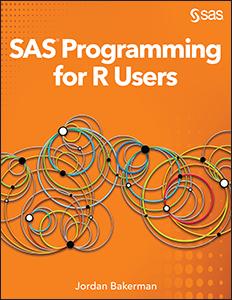At SAS Press, we agree with the saying “The best things in life are free.” And one of the best things in life is knowledge. That’s why we offer free e-books to help you learn SAS or improve your skills. In this blog post, we will introduce you to one of our amazing titles that is absolutely free.
SAS Programming for R Users
 Many data scientists today need to know multiple programming languages including SAS, R, and Python. If you already know basic statistical concepts and how to program in R but want to learn SAS, then SAS Programming for R Users by Jordan Bakerman was designed specifically for you! This free e-book explains how to write programs in SAS that replicate familiar functions and capabilities in R. This book covers a wide range of topics including the basics of the SAS programming language, how to import data, how to create new variables, random number generation, linear modeling, Interactive Matrix Language (IML), and many other SAS procedures. This book also explains how to write R code directly in the SAS code editor for seamless integration between the two tools.
Many data scientists today need to know multiple programming languages including SAS, R, and Python. If you already know basic statistical concepts and how to program in R but want to learn SAS, then SAS Programming for R Users by Jordan Bakerman was designed specifically for you! This free e-book explains how to write programs in SAS that replicate familiar functions and capabilities in R. This book covers a wide range of topics including the basics of the SAS programming language, how to import data, how to create new variables, random number generation, linear modeling, Interactive Matrix Language (IML), and many other SAS procedures. This book also explains how to write R code directly in the SAS code editor for seamless integration between the two tools.
The book is based on the free, 14-hour course of the same name offered by SAS Education available here. Keep reading to learn more about the differences between SAS and R.
SAS versus R
R is an object-oriented programming language. Results of a function are stored in an object and desired results are pulled from the object as needed. SAS revolves around the data table and uses procedures to create and print output. Results can be saved to a new data table.
Let’s briefly compare SAS and R in a general way. Look at the following table, which outlines some of the major differences between SAS and R.
Here are a few other things about SAS to note:
- SAS has the flexibility to interact with objects. (However, the book focuses on procedural methods.)
- SAS does not have a command line. Code must be run in order to return results.
SAS Programs
A SAS program is a sequence of one or more steps. A step is a sequence of SAS statements. There are only two types of steps in SAS: DATA and PROC steps.
- DATA steps read from an input source and create a SAS data set.
- PROC steps read and process a SAS data set, often generating an output report. Procedures can be called an umbrella term. They are what carry out the global analysis. Think of a PROC step as a function in R.
Every step has a beginning and ending boundary. SAS steps begin with either of the following statements:
- a DATA statement
- a PROC statement
After a DATA or PROC statement, there can be additional SAS statements that contain keywords that request SAS perform an operation or they can give information to the system. Think of them as additional arguments to a procedure. Statements always end with a semicolon!
SAS options are additional arguments and they are specific to SAS statements. Unfortunately, there is no rule to say what is a statement versus what is an option. Understanding the difference comes with a little bit of experience. Options can be used to do the following:
- generate additional output like results and plots
- save output to a SAS data table
- alter the analytical method
SAS detects the end of a step when it encounters one of the following statements:
- a RUN statement (for most steps)
- a QUIT statement (for some procedures)
Most SAS steps end with a RUN statement. Think of the RUN statement as the right parentheses of an R function. The following table shows an example of a SAS program that has a DATA step and a PROC step. You can see that both SAS statements end with RUN statements, while the R functions begin and end with parentheses.
If you want to learn more about this book or any other free e-books from SAS Press, visit https://support.sas.com/en/books/free-books.html. Subscribe to our newsletter to get the latest information on new books.


